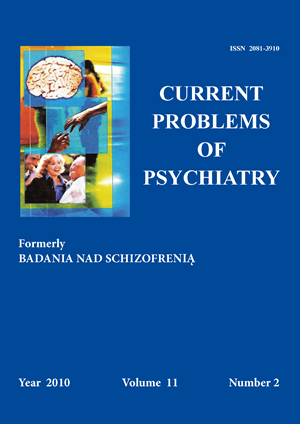Przemoc domowa – różne definicje, różne reakcje - przegląd piśmiennictwa
Słowa kluczowe:
przemoc domowa, skutki zdrowotne, depresjaAbstrakt
Przemoc nie jest zjawiskiem nowym. Przemoc i jej skutki można rozpatrywać w różnych dziedzinach: przemoc w pracy, szkole czy przemoc w rodzinie. Można na nią także spojrzeć także z perspektywy psychologicznej, etycznej, prawnej lub społecznej. Przemoc jest pojęciem wieloznacznym.
Z tego też powodu precyzyjne określenie definicji przemocy domowej nie jest prostym zadaniem. Tak jak istnieją różne definicje przemocy w rodzinie czy przemocy domowej, różne są też jej skutki, w tym także długoterminowe konsekwencje dla zdrowia osób doświadczających przemocy. Ofiary przemocy doznają różnych zmian nie tylko w sferze emocjonalnej ale także - u niektórych – dochodzi do zmian w postrzeganiu siebie i otaczającego świata. Niejednokrotnie ofiary przemocy zgłaszają również różne objawy fizyczne nie znajdujące wyjaśnienia w badaniach medycznych.
Bibliografia
1. Seneka, De Clementia XXIV, cyt. za Filozofia starożytna Grecji i Rzymu. Warszawa: 1968, s. 331.
2. Milewska M. Ocet i łzy. Terror Wielkiej Rewolucji Francuskiej jako doświadczenie traumatyczne. Gdańsk: 2001, s. 17. (tyt.orginału: J. de Maistre: Considérations sur la France, éd. J. Tulard, Paris: 1980, s. 31.
3. Salber P., Taliaferro E. O przemocy domowej. Poradnik dla lekarza pierwszego kontaktu. Warszawa; PARPA: 1998, s. 25.
4. Mellody P. Toksyczne związki – anatomia i terapia współuzależnienia. Warszawa; Jacek Santorski &CO Agencja Wydawnicza: 1993, s. 15.
5. Frączek A.F. (red.), Studia nad uwarunkowaniami i regulacją agresji interpersonalnej. Wrocław: Ossolineum; 1986.
6. Bielawska-Batorowicz E. O formach złego traktowania dzieci. Przegl. Psychologiczny, 1993; 36(3): 306.
7. Sztander W. Na czym polega pomaganie ofiarom przemocy. „Niebieska Linia ”, pismo Ogólnopolskiego Porozumienia Osób, Organizacji i Instytucji Pomagającym Ofiarom Przemocy, 1999; 5/99: 18.
8. Górniewicz J., Przemoc w szkole. Zarys problemu, cz. I, Wychowanie na co dzień. 1995; nr 2.
9. Olechnicki K., Załęcki P., Słownik socjologiczny. wyd. II poprawione, Toruń; Graffiti BC: 1988, s.167.
10. Mellibruda J. Oblicza przemocy. Warszawa; Remedium: 1993.
11. Pospiszyl I. Razem przeciw przemocy. Warszawa; wyd. akademickie „Żak”: 1999, s. 16.
12. Krauss H.H., Krauss B.J. Domestic violence and its prevention. W: Adler L.L, Denmark F. L. red., Violence and prevention of violence. Westport; CT Praeger: 1995, s.129-144.
13. Dziennik Ustaw Nr 180 pozycja 1493 z 20 września 2005.
14. DSM IV - kryteria diagnostyczne, red. Wciórka J. wyd. Elsevier: 2008.
15. Herman L.J. Przemoc. Uraz psychiczny i powrót do równowagi. Gdańsk: Gdańskie wydawnictwo psychologiczne; 2004: s.130-133.
16. Plichta S. The effects of woman abuse on health care utilization and health status: a literature reviev. Woman’s Health Issues, 1992; 2(3), 154-163.
17. Campbell J.C., Webster D., Kozioł-McLain J., Block C., Campbell D., i wsp. Risk factors for femicide in abusive relationships: Results from a multisite case control study. Am. J. Public Health, 2003; 93(7): 1089-1097.
18. Cascardi M., O’Leary D., Schlee K. Forced sex and intimate partner violence: effects on women’s risk and women’s health. Violence Against Women, 1999; 5(9) 1017-1035.
19. Cascardi M., O’Leary D., Schlee K. Forced sex and intimate partner violence: effects on women’s risk and women’s health. Violence Against Women, 1999; 5(9) 1017-1035.
20. Coker Al., Davis K.E., Arias I, i wsp. Physical and mental health effects of intimate partner violence for men and women. Am. J. Prev. Med., 2002; 23: 260-268.
21. Nicolaidis C., Curry M., McFarland B., Gerrity M. Violence, mental health, and physical symptoms in an academic internal medicine practice. J. Gen. Intern. Med., 2004; 19: 819-827.
22. Golding J.M.. Intimate partner violence as a risk factor for mental disorders: A meta-analysis. J. Fam. Violence, 1999; 14(2): 99-132.
23. Brokaw J., Fullerton-Gleason L., Olson L., Crandall C., Mclaughlin S., Sklar D. Health status and intimate partner violence: S cross-sectional study. Ann. Emerg. Med. 2002; 39: 31.
24. Wingood G.M., DiClemente R.J., Raj A. Adverse consequences of intimate partner abuse among women in non-urban domestic violence shelters. Am. J. Prev. Med. 2000; 19: 270-275.
25. Kessler R.C., Nelson C.B., McGonagle K.A., Liu J., Swartz M., Blazer D.G. Comorbidity of DSM-III-R major depressive disorder in general population: Results for the US National Comorbidity Survey. Br. J. Psych., 1996; 168 (suppl. 30), 17-30.
26. Kelly K.D., DeKeserdy W.S. Women’s fear of crime and abuse In college and university dating relationships. Violence Vict., 1994; 9: 17-30.
27. Bonomi A.E., Anderson M.L., Rivara F.P., Thompson R.S. Health outcomes in women and physical and sexual intimate partner violence exposure, J. Women’s Helth 2007; 16(7): 987-995.
28. Follette V.M., Polusny M.A., Bechtle A.E., Naugle A.E. Cumulative trauma: The impact of child sexual abuse, adult sexual assault, and spouse abuse. J. Trauma. Stress, 1996; 9(1), 25-35.
29. McCauley J., Kern D., Kolodner K., Derogatis L., Bass E. Relation of low-severity violence to women’s health. J. Gen. Intern. Med., 1998; 13; 687-691.
30. Wijma K., Samelius L., Wingren G., Wijma B. The association between ill-health and abuse: A cross-sectional population based study, Scand. J. Psychology, 2007; 48, 567-575.
31. Stein M., Kennedy C. Major depressive and post-traumatic stress disorder comorbidity in female victims of intimate partner violence. J.Affect Disord. 2001; 66 (2-3): 133-38.
32. Coker A., Weston R., Creson D., Justice B., Blakeney P. PTSD symptoms among men and women survivors of intimate partner violence: the role of risk and protective factors. Violence Vict., 2005; 20; 625-43.
33. Fedovskiy K., Higgins S., Paranjape A. Intimate partner violence: How does it impact major depressive disorder and post traumatic stress disorder among immigrant latinas? J. Immigrant Minority Health, 2008; 10: 45-51.


